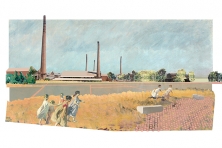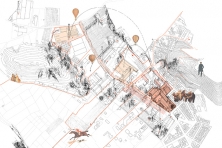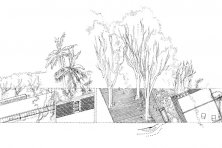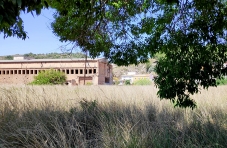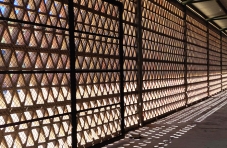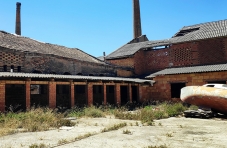Loop-Settling
Oliva (ES) – Mention Spéciale

Y. Juan, J. Juan Roy, A. Alejandro, A. María Villalba, B. Henao, A. Vargas, P. Herrero, A. Morro, V. Muñoz, F. Piño, M. Pitarch, S. Estruch, F. Navarro, E. Juanes, S. García & R. Piñol
DONNÉES DE L'ÉQUIPE
Représentant de l'équipe : Yasmina Juan (ES) – architecte urbaniste ; Associés : Jorge Juan Roy (ES), Alejandro Alejandro (ES), Ana María Villalba (ES), Brandon Henao (ES), Ana Vargas (ES), Pascual Herrero (ES), Anna Morro (ES), Víctor Muñoz (ES), Francisco Piño (ES), María Pitarch (ES), Sergio Estruch (ES) – architectes ; Fernando Navarro (ES) – architecte urbaniste ; Elisa Juanes (ES), Sara García (ES) – Ingénieurs-architectes ; Rebeca Piñol (ES) – étudiant en arts graphiques
C/ Padre Huérfanos nº16 Bajo Derecha, 46003 Valencia (ES)
+34695444215 - yasmina@elfabricantedeespheras.com
Voir la liste complète des portraits ici
Voir la page du site ici
INTERVIEW (en anglais)
1. How did you form the team for the competition?
The team is the sum of three freelance architects and the cooperative El fabricante de espheras. We met by common friends and realized that we share many interests in the field of architecture such as the recovery of disused architectures – with heritage value or not - and we wanted to try a joint so the Europan competition was an excellent opportunity.
2. How do you define the main issue of your project, and how did you answer on this session main topic: the place of productive activities within the city?
In the case of Els rajolars de Oliva, the main issue to solve is the reactivation of the area after the decline of the ceramic industries implanted there. The size of the area makes essential to think not only about the activities that can have a place in a peri-urban area-and how to integrate them into the functioning of the city and the rural environment that surrounds it- but also the methodology of management and process necessary to make it happen. This is combined with a careful look at the ceramic landscape of the area which seeks to put in value various elements such as ovens, dryers, latticework, fireplaces and to adopt ceramic construction solutions to new interventions. In connection with the topic of this session, we see that the area suffers from the abandonment generated after the failure of monofunctional production models. In this sense, and in relation to re-integration with the city, it seems essential to establish indicators of occupancy densities and diversity of uses. Also it’s a space of opportunity as a node of articulation between rural and urban contexts, with the possibility of materializing the connections between the territorial and the urban green-blue infrastructures.
Els Rajolars is by definition a productive area so the challenges addressed by the project are aimed at recovering and enhancing this productive character and at the same time introducing new uses of the complex city (residential and services). It is a question of achieving a greater mixicity of uses, and therefore a greater resilience of the area to the cycles of productive activities, reducing fragility.
4. Have you treated this issue previously? What were the reference projects that inspired yours?
Yes, on a smaller scale, specifically in the recovery of La campaneta ceramic slate factory, in Onda, a Castellón’s town. This Project consists of the definition of a master plan for a phased rehabilitation of the factory as neighborhood equipment. Also, as a reference The Alhambra has been the main one, for its analogy with the rajolars as a complex of buildings articulated by green and water spaces, in addition to the aesthetic use of ceramics. We can also name Sesc Pompeia for the work done to preserve the pre-existences, the memory of the place and the definition of a street that links all kinds of activities, getting that what happens inside overflows into the space Public. Or the management system of the Westerpark in Amsterdam in terms of introduction new uses by the own agents involved in the project.
5. Urban-architectural projects like the ones in Europan can only be implemented together with the actors through a negotiated process and in time. How did you consider this issue in your project?
The management process of the urban revitalisation process is one of the basic pillars, not to mention the main one on which the proposal is based. We believe that without proper design of the management process it will be unfeasible to implement activities and regenerate an area of this size. That’s why we’ve focused on the definition of the process, of the Office of Management, and to set out a criteria (environmental, social, materialization and use of spaces) that actions should follow, while the more formal aspects should be worked from co-design with the agents involved and the citizenry themselves.
6. Is it the first time you have been awarded a prize at Europan? How could this help you in your professional career?
In the 8th edition of EUROPAN, Fernando Navarro and Pasqual Herrero received the Runner-up prize for the location of Sintra (Portugal), which served as a push to later found the cooperative El Fabricante de espheras. For the rest of the team, this is the first time we've participated. We think that at professional level this type of competitions allow us to create free thought frameworks on topics that interest us and from which we can then continue deepen on the daily work.
IDENTITÉ DE L'ÉQUIPE
Office: -
Functions: Architecture, urban planning, engineering, graphics
Average age of the associates: 30 years old
Has your team, together or separately, already conceived or implemented some projects and/or won any competition? If yes, which ones?
- First prize international contest Plaza del Raval de Sant Josep, Onda SPAIN. 2012 (el fabricante de espheras)
- First prize international sports palace competition Award, Kaluga. Russia. 2013 (el fabricante de espheras)
- el CASC- European Young Planning Professionals Award 2014, COACV Award 2013-2014 Solidarity Coacv Modality and Active Public Space Award 2016 (el fabricante de espheras)
- Castle-palace Betxí, ASCER ceramic award, interior design category 2014 (el fabricante de espheras)
- Pla Xativa! - Process of citizen participation for the Historic Center of Xativa. Housing, Mobility and Urban Award (el fabricante de espheras)
- First prize competition SOM ceramic to urban regeneration -CRU- 2019, Castellón. Camino de San Miguel. First prize. (Alejandro, Ana, Brandon)
- Driehaus Competition 2019. Mention. (Alejandro, Ana, Brandon)
- Competition som ceramic to urban regeneration -CRU- 2018, Castellón. The pine forest and the path. First Mention. Grass blade. Second Mention. (Alejandro, Ana, Brandon)
- Park project with rock climbing, skateboarding, skating and playground in Bétera. (Alejandro, Ana, Brandon)
